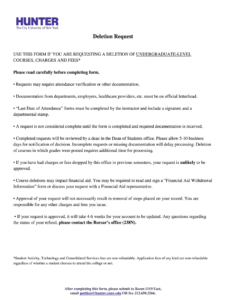Utilizing a pre-designed structure streamlines the exercise of data subject rights, reduces ambiguity, and helps organizations avoid potential legal complications. This also benefits organizations by ensuring they receive the necessary information to process requests efficiently and accurately.
This article will further explore the practicalities of using such forms, examining best practices for completion, common pitfalls to avoid, and how organizations can benefit from incorporating them into their data protection procedures.
Key Components of a Data Removal Request Form
Effective data removal requests require specific information to ensure clarity and facilitate efficient processing. The following components are crucial for a comprehensive request:
1: Data Subject Identification: Clear identification of the individual making the request, including full name, address, and any other relevant identifying information, is essential.
2: Contact Information: Providing an email address and/or phone number allows the organization to contact the requestor for clarification or updates regarding the request.
3: Data Specification: The request should clearly specify the data the individual wishes to have removed. This may include specific categories of data or specific data points.
4: Justification for Removal: While not always mandatory, providing a reason for the removal request can assist the organization in understanding the request and processing it efficiently.
5: Proof of Identity: Organizations may require proof of identity to ensure the request is legitimate and protect against fraudulent requests. This might include a copy of a passport or driver’s license.
6: Date of Request: Including the date provides a clear record of when the request was submitted, aiding in tracking and timely processing.
7: Signature (where applicable): A signature can further validate the authenticity of the request, particularly for physical or scanned forms.
Accurate and complete information in these areas ensures efficient processing, minimizing delays and facilitating the timely exercise of data subject rights.
How to Create a GDPR Data Removal Request Form
Creating a standardized form for data removal requests promotes efficiency and ensures compliance with GDPR requirements. The following steps outline the process of developing a comprehensive and effective form.
1: Template Selection: Begin by selecting an appropriate template format. This could be a simple text document, a spreadsheet, or a more sophisticated online form. The chosen format should allow for clear organization and easy completion.
2: Data Subject Identification Section: Include fields for the requestor’s full name, address, and any other relevant identifying information, such as a customer or account number.
3: Contact Information Section: Provide fields for an email address and phone number to facilitate communication regarding the request’s status.
4: Data Specification Section: Include a section where the requestor can clearly specify the data they wish to have removed. This can include checkboxes for common data categories or a free-text field for more specific requests.
5: Justification Section (Optional): While not mandatory, a field for providing a reason for the request can be helpful.
6: Proof of Identity Section: Explain the requirement for proof of identity and specify acceptable forms, such as a copy of a passport or driver’s license.
7: Date and Signature: Include fields for the date of the request and a signature, if applicable.
8: Clear Instructions: Provide concise, easy-to-understand instructions for completing the form. This should include information on where to submit the completed form and expected processing times.
A well-designed form ensures that requests are clear, complete, and easy to process, facilitating the efficient and compliant handling of data removal requests. This benefits both individuals exercising their rights and organizations managing these requests. Regularly reviewing and updating the form helps maintain its effectiveness and relevance.
Standardized forms for requesting data removal under GDPR provide a crucial framework for individuals seeking to exercise their data protection rights and for organizations to comply with these requests efficiently. Understanding the key components of these forms, including clear identification, data specification, and proof of identity, empowers individuals to submit effective requests. Organizations benefit from implementing structured forms by streamlining their processing procedures, reducing ambiguity, and minimizing legal risks.
Effective data management necessitates a clear and consistent approach to handling data removal requests. Adopting standardized procedures through well-designed forms represents a proactive step towards ensuring compliance and building trust in data handling practices. Continued focus on these practices will become increasingly vital as data privacy regulations evolve and data subject awareness grows.

